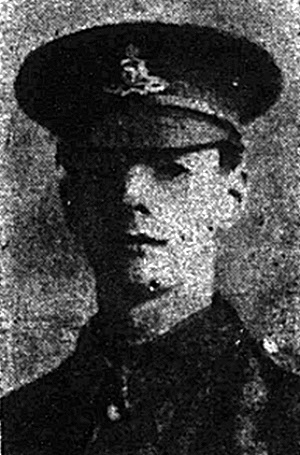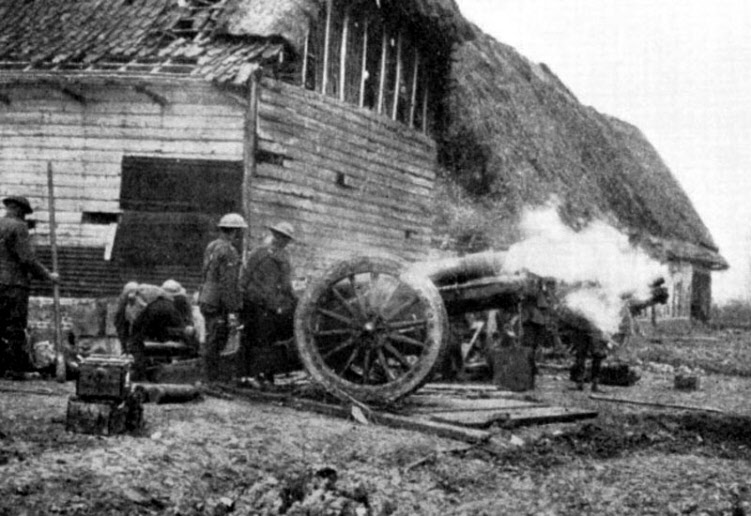
Lionel Henry Rooke was born in Ossett in late 1893, the third child and third son of eight children born to Thomas Thorpe Rooke and his wife Fanny (nee Walmsley) who were married in late 1886 in Barrow in Furness. Sadly three of the children died before April 1911.
The Rooke family, originally from Barnsley, arrived in Ossett in the early 1890s and by 1891, Insurance Agent Thomas and his family had left for Batley, where they were in 1911. By this time Thomas Rooke was a newsagent and stationer, whilst Lionel was a grocer’s assistant.
Lionel Henry Rooke of 29, Field Lane, Batley, aged 22 years and 4 months, a grocery manager by trade, enlisted at Batley on the 1st December 1915 and was posted to B Reserve. Tall for his age at 6’ 0½ inches, he joined the Royal Garrison Artillery with service number 77685 on the 3rd May 1916 and was posted to R.G.A., 13 Company on the 22nd August 1916.
His record indicates that he passed through the gas standard tests in anti-gas measures in early April 1917. He was then posted to the 341st Siege Battery on the 27th May 1917 and embarked from Southampton on the 29th May, arriving at Havre France the following day and was posted to the 223rd Siege Battery, where he served for the remainder of his War. Lionel Rooke was a wireless operator and as such would have spent most of his time with the gun battery, housed in a dugout next to the guns, manning the wireless equipment and communicating with the crew of whichever aircraft that happened to be working with the 223rd Siege Battery in helping them train their guns on to enemy targets.
Gunner Lionel Henry Rooke was killed in action two months later on the 31st July 1917. His effects were returned to his father and comprised his disc, leather letter case, photographs, small pair of pliers, two pencils, two buttons, a letter card and 15 French francs. He was posthumously awarded the British and Victory medals.
Siege Batteries RGA were equipped with heavy howitzers, sending large calibre high explosive shells in high trajectory, plunging fire. The usual armaments were 6 inch, 8 inch and 9.2 inch howitzers, although some had huge railway or road-mounted 12 inch howitzers. As British artillery tactics developed, the Siege Batteries were most often employed in destroying or neutralising the enemy artillery, as well as putting destructive fire down on strongpoints, dumps, store, roads and railways behind enemy lines.
223rd Siege Battery, RGA went to France on the 2nd December 1916 and joined 19th Heavy Artillery Group (HAG) on the 7th December 1916. At the time it was armed with four 6-inch howitzer (26 cwt). On the 25th March 1917, it transferred to 58th HAG; to 46th HAG on the 13th April 1917; to 51st HAG on the 25th May 1917 and to 70th HAG on the 20th June 1917. In July 1917, it was made up to six guns by the addition of one section from 360th Siege Battery and it joined 4th Brigade, RGA on the 24th October 1917 and remained with it until the end of the war.
The Siege Batteries fired the heaviest weapons in the British arsenal and were used to batter enemy strongpoints. The size and weight of the guns meant that they were not very mobile and, in fixed positions, it would not take the Germans too long to identify their location. Gunner Lionel Rooke was killed on the opening day of the Third Battle of Ypres, which began on the 31st July 1917.
The “Batley News” had an obituary for Lionel Rooke:
“Popular Batley Soldier Killed in Action – Three Other Brothers With The Force:
Official news was received on Saturday of the death in action on July 31st, of Gunner L.H. (Harry) Rooke, R.G.A., wireless operator with the British Forces in France, son of Mr. and Mrs. Tom Rooke, newsagents, Field Lane, Batley.
A few days before falling in battle, Gunner Rooke, who was 23 years of age, wrote letters to friends at Wakefield and to his family. To the former, he wrote this remarkable epistle! ‘We are in a broken-down spot, but the garden nearby is still in full bloom, and there are some lovely roses. You would like a bunch, but instead I will press one out and you can keep it. When I see you again I will tell you all about what was once a lovely convent, when quiet maids walked about, no doubt without being troubled by men. Now a change is to be seen, for man is arranged to destroy, until out of destruction, we may once more have peace, and one more lasting than before, and a standing menace for ever done in, so that no more young and old will be away from home except in peaceful pursuits.’ With the letter he enclosed two pressed flowers – a rose and a pansy from the ruined garden.
In a letter to his parents two days before he was killed, he acknowledged the receipt of a copy of the ‘News’ and said he had enjoyed reading the news from Blighty. Writing of his wireless work, he said: ‘We are with the guns and near them. I am quite content if we are only giving Fritz a smack that he cannot get over, and shortly you should read of good news to make up for the past few weeks of silence.’ In a previous letter he referred to his meeting with a Batley lad named Asquith, who was helping him put an air-shaft in a dug-out. Gunner Rooke was well-known in Batley where his sunny disposition was appreciated.
As a lad, he worked under Messrs. Wyman at their railway bookstall in Batley and was then promoted to Huddersfield. However, at the age of sixteen, he left bookstall work and entered the employ of Hunters, the tea-men. From their Huddersfield shop he was transferred to Wakefield, where he became an assistant, and his last post before joining the Colours was that of manager of the firm’s Featherstone branch. He and his family have been attached to the Catholic Apostolic Church, Upper Howard Street, Batley, where the deceased was a member of the choir. He went to the Army in May 1916 and a year later was drafted out to France.
Three brothers are doing their bit in various directions. The eldest, Private Walter Rooke (28), R.A.M.C., formerly a hairdresser in Leeds, is doing duty in Salonica. Driver Tom Rooke (26), M.T. Army Service Corps, who was chauffeur for Dr. Moore, of Holbeck, is now in hospital in France, after 26 months of continuous driving at the Front. Ordinary seaman Alex Rooke (21), R.N., who was a tuner at Messrs. G. and J. Stubley’s mill is now on Admiral Sturdee’s flagship. The Rooke family have done well for their country, and keen sympathy will be felt for Mr. and Mrs. Rooke in the loss of their promising son.”
This report was followed up a few weeks later in the “Batley News” of the 22nd September 1917 (with thanks to Val Mitchell) by an account of how Lionel Rooke met his death:
“A Favourite in his Battery – Further News as to How a Popular Batley Gunner Met His Death – Consolatory details as to the circumstances under which their gallant son, Gunner L.H. (Harry) Rooke, R.G.A., wireless operator with the British Forces in France, met his death have this week been received by Mr. Thomas Rooke, newsagent, and Mrs. Rooke, of Field Lane, Batley.
Second-Lieutenant R. Read, an officer of the deceased’s battery, writes:-
‘I grieve with you in the loss of your dear son. Your loss was ours in the passing of such a gallant British soldier. He was with me on the afternoon of the 31st July on a special task, and he was in the best of spirits. The job was a dangerous one, and we all knew that at any moment one of us or all of us might be called to a better and more peaceful world. I left your son with three others under cover of an old trench, whilst I went forward to another position, and whilst away a stray shell dropped in their midst, and your son was killed instantly. He suffered no pain, the end was swift. There were other casualties, and your son was buried alongside other poor boys who had been killed at the same time. Where they are buried, I am unable to say, but I will use every endeavour to find out. I cannot promise if I will be successful or not.
I beg of you to be tolerant with me. The reason you have not been written to is that we have had numerous changes in the command of this battery. I am afraid this letter will be little consolation to you, but I have done my best to give you as many details as possible. I might say that your dear son was a great favourite in the battery, and as good a soldier as I have ever met during my thirty months in this God-forsaken country. I I can be of any further service to you, don’t be afraid to write.’
It will be remembered that Gunner Rooke was one of four brothers ‘doing their bit’ in various directions. Before joining up he was the manager of the Featherstone branch of Hunters, the tea men. As a lad he worked under Messrs. Wyman at their railway bookstall in Batley, and was very well-known in the town as possessing a very sunny disposition.”
Lionel Henry Rooke is not remembered on any Ossett Memorial or Roll of Honour, which is probably due to his family’s departure from Ossett in the early 1890s He is remembered in this 2014 biography and Roll of Honour because the Commonwealth War Graves Commission and/or the “U.K. Soldiers who Died in the Great War 1914-1918” listing records him as born or residing in Ossett.

Above: 6″ Howitzer like the ones in Gunner Lionel H. Rooke’s 223rd Siege Battery.
Gunner Lionel H. Rooke, aged 24 years, son of Thomas Thorpe Rooke and Fanny Rooke, of 29, Field Lane, Batley, Yorks and a native of Ossett, Yorkshire died on the 31st July 1917 and is buried at grave reference E. 8. at the Track X Cemetery,1 Ieper, West-Vlaanderen, Belgium. The cemetery is located to the North-East of the town of Ieper.
The site of the cemetery was between the Allied and German front lines in June 1917. The cemetery was begun by the 39th and 48th (South Midland) Divisions at the end of July, after Commonwealth forces advanced on this front. It was closed in November 1917, except for two burials in May 1918.
There are now 149 First World War burials in the cemetery, 27 of them unidentified.
References: